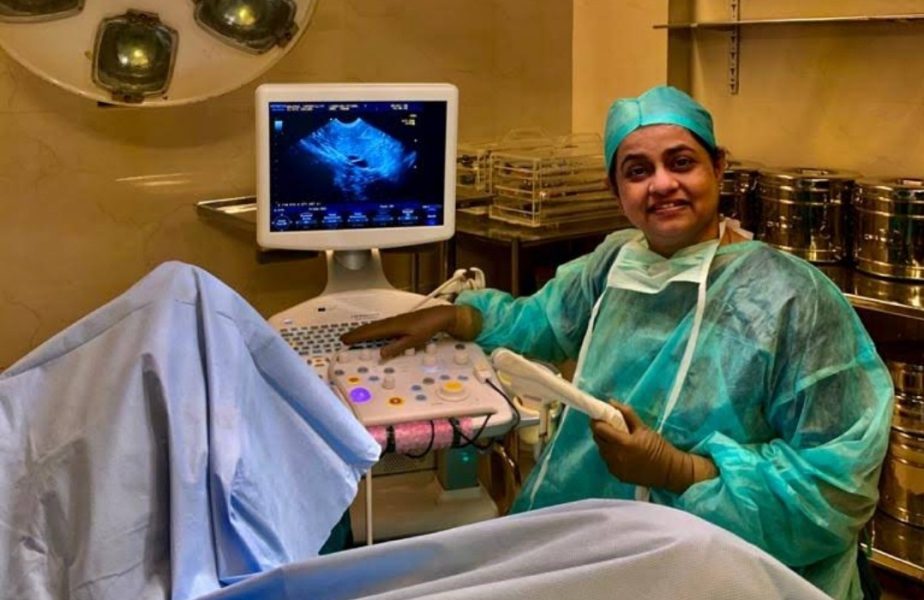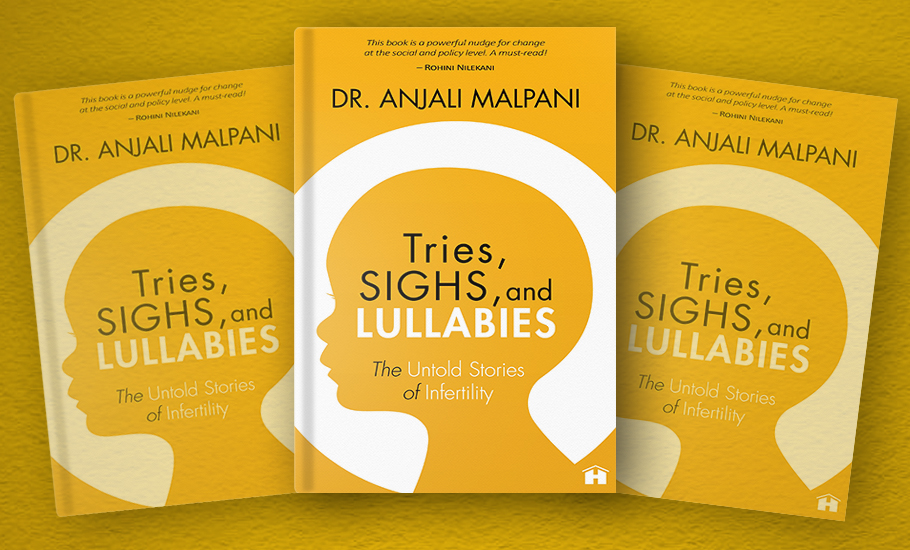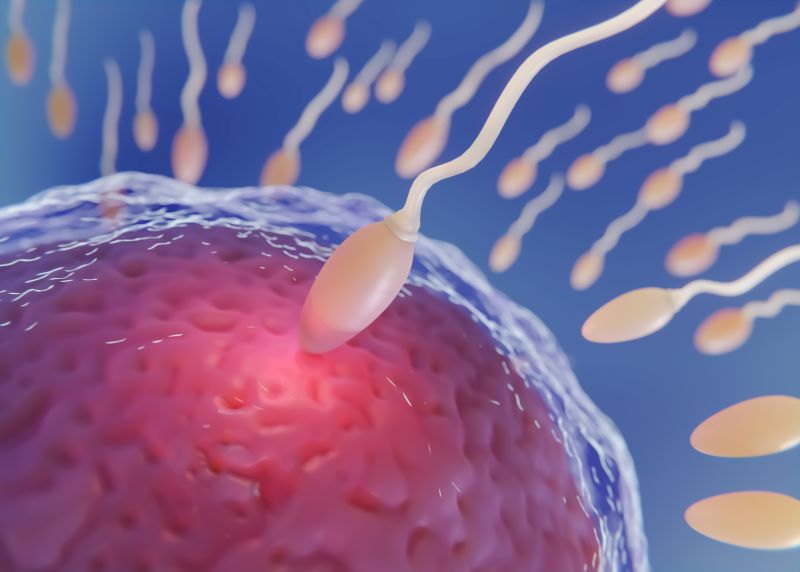
IVF specialist Dr Anjali Malpani recounts untold stories of infertility, surrogacy, adoption

According to an early 2023 World Health Organisation (WHO) report, “one in six people” experience infertility worldwide, which in turn necessitates the strengthening of the medical infrastructure with reference to easy and cost-effective accessibility to In vitro fertilization (IVF) treatments and procedures. In India, a rise in the number of infertility cases has led to a steady expansion of the Assisted Reproductive Technology (ART) market, with new centres and facilities growing in recent years. However, questions regarding acceptability, fetal morbidity, maternal health, affordability, and efficacy continue to bother distressed couples in India.
In an exclusive conversation with The Federal, leading IVF specialist and the founder of India’s first sperm bank in the 1990s, Dr. Anjali Malpani talks about her latest book, Tries, Sighs, and Lullabies: The Untold Stories of Infertility (Hay House Publishing), and shares insights on issues related to infertility, surrogacy, sperm/egg donation, and adoption in India — topics that are otherwise seldom engaged with in mainstream discussions.
What lends Dr. Malpani’s book a sense of diversity and intersectionality is the fact that this anthology of fifteen stories include narratives from a wide spectrum — a gay couple recount their struggle amid legal battles to have their IVF child, a husband cannot muster courage to tell his wife he was the victim of mass sterilisation during the Emergency period in India, and a woman realises she was born without a womb.
Infertility: Still a taboo?
In India, infertility is considered a taboo. Given the gender norms in a patriarchal society like ours, the woman invariably becomes the subject of social stigma, neglect, and discrimination. As an IVF specialist for over three decades, Dr. Malpani has observed that couples are steadily warming up to the idea of IVF treatments but the prejudice and hesitation continue.
“India has progressed in the IVF (sector), especially in ART, where a lot of advances are being made. We are on par with almost all the foreign countries and our success rates are equally good. But India being a patriarchal and pro-natalist society, unfortunately, the stigma and shame of infertility remain. This is particularly true for small towns and rural villages where women (who cannot conceive) are looked down upon, ostracised, discriminated against, and ill-treated,” she asserts.

Technologically, we might have progressed but the stigma trails like a shadow. For example, Dr. Malpani recounts, “When I tell patients to come for a sonography; often, they won’t tell at their workplaces they’re going for an IVF treatment or an ultrasound; they would rather say, they’re going to a dentist.” Tries, Sighs, and Lullabies aims to dispel such misconceptions related to infertility, which must be treated like any other disease or medical disorder without any moral judgement. In terms of ‘accepting’ the treatment, there is a huge change, feels Dr. Malpani.
Also read: IVF for aged couples remains a question of medical ethics, child rights
“When we started India’s first sperm bank in 1990, it came as a rude shock to many people as the word ‘sperm’ was taboo. Even my mother would get angry at me. Today, I am proud to say that my husband Dr. Aniruddha and I have changed the system by boldly giving interviews to the Press and educating the people about infertility. We were, in fact, the advisors for Vicky Donor (Shoojit Sircar’s 2012 movie) and with the release of such films, people came to know more about sperm/egg donation, infertility, and surrogacy,” she recalls.
The story of one of India’s first IVF clinics
The Malpani Infertility Clinic, founded by Dr. Anjali Malpani, along with husband Dr. Aniruddha Malpani, opened its doors to childless couples in 1990. In 1983, when Dr. Malpani was a resident in a Mumbai hospital, she would see patients thronging the gynae OPD. “At that point, women would come but wouldn’t say anything, they would often complain of a backache and they would be told to take B-Complex tablets or advised to go on a holiday, etc.,” recalls Dr. Malpani.
As she felt something was amiss, she began talking to these women during her lunch break and was startled at what came out of the interactions. “I realised they actually wanted a child desperately but could not get themselves to talk about it. That is when I learned about their depression, desolation, and isolation,” shares the IVF specialist, talking about how the seeds of becoming an IVF doctor were sown. “I thought I must do justice to such patients. Remember, this was also the time when Louise Joy Brown was already born (world’s first ‘test tube’ baby) in England in 1978, and there were lots of exciting articles being published in journals, and there was news about IVF babies being born in England, Australia, and the US. I decided to learn more about IVF and make the treatment available to Indians,” says Dr. Malpani.
Though she was in a teaching hospital, IVF was still not part of the academic curriculum during her time. “Even today, you’d be surprised to know, ART is not taught at government or municipal hospitals, which is a shame, because 17.5% couples in the world are infertile today,” informs Dr. Malpani, who had applied to a number of colleges abroad until she received a prestigious fellowship from Mumbai with which she went to King’s College, London, to pursue her dream and study the various techniques for ART. Upon returning to India, she thought starting an IVF clinic would be a cakewalk, given her knowledge and expertise, but fate had other plans.

“As my parents-in-law already had a nursing home, I assumed we could start right away. But things were not that simple. Just breaking down walls and making a laboratory for IVF was not enough, as we needed an embryologist to run the lab and in India, nobody had even heard of an ‘embryologist’! Luckily, my husband (who was at King’s College, too) had picked up a lot of information and knowledge about embryology and related protocols. So, we thought he would go ahead and start the IVF lab. We began writing letters abroad requesting for IVF medium (culture media that supports cell growth). The Customs officials did not know what infertility or IVF was, and the shelf-life of the media we ordered would almost expire by the time it could be cleared (from Customs) after a lot of pleading,” shares Dr. Malpani.
When the couple started India’s first sperm bank, initially, they had no idea about how to procure liquid nitrogen, which is crucial for storing frozen sperms. “We soon learnt that Aarey Milk Colony in the (Mumbai) suburbs had liquid nitrogen cans, as bulls were inseminated there to produce more milk. We would carry these liquid nitrogen cans in the backseats of our car, and routinely get caught by the police! Of course, there were bigger problems since people did not know what infertility or IVF was and we had to educate them. Today, I can proudly say, my husband and I are pioneers in patient education in India for we were the ones who began openly talking to the Press about IVF at a time when no one else was ready to do so. Gradually, we started getting patients from all over the country,” shares Dr. Malpani.
Infertility: a woman’s problem only?
One of the stories in the anthology reveals a man’s sense of pride coming in the way of accepting ‘donor sperms’ as a method to treat infertility. However, the idea of ‘donor eggs’ agrees with the same man later. As an IVF specialist and a feminist, Dr. Malpani navigates these uneven, ideological terrains during consultations. “India is a patriarchal society where men are considered superior, rational, and are the decision-makers in the family, while women are submissive to their authority. Also, virility is confused with sperm count,” informs Dr. Malpani, and adds, it is only after performing a semen test that a man’s sperm count can be ascertained.
Also read: Gujarat IVF centres continue to act as ‘boy-producing factories’ with impunity
“The wives are unnecessarily blamed and made to undergo hundreds of tests while the man does not even bother to do a single, simple sperm test! Now, I do the sperm test first before testing the woman,” says Dr. Malpani. She agrees that not long ago, the brunt of infertility was on the women, and the men would not even turn up for tests. “Procedures like D&C (involves cleaning of the uterus) and diagnostic laparoscopy were done repeatedly on the women. In the last 30 years, more technologies have come in the field of AR,” she adds.
When the couple had started, the IVF success rate for a woman less than 35 years of age was 5–10% and today, they have reached a success rate of 40–45%. “This means, almost every couple that comes to us can dream of a baby. Egg freezing has also come a long way. About 15 years ago, when we froze 10 eggs, only one would survive because these are delicate and get damaged during the freezing process. But today, when we freeze and thaw 10 eggs, we have a 100% survival rate,” she says, adding that a procedure called intracytoplasmic sperm injection (ICSI) has revolutionised the treatment of male infertility. “It is a procedure whereby the testicular extraction of sperms, also mentioned in one of my stories, is possible, and a man with a zero sperm count can father his own baby today,” informs Dr. Malpani.
More than the subject of ‘treating’ infertility, Tries, Sighs, and Lullabies brings forth a significant aspect of parenting and parenthood, i.e., a child is a gift, no matter their biological identity. “Some couples do have reservations in accepting donor eggs or sperm. Often, their worry or dilemma is, what if the child is ill-treated or simply not accepted later by their partners? Adoption is usually the last resort for couples, but I offer this option right at the start of every consultation because these are multiple ways of building a family. A child is a child, after all. Once born, the details of the birth do not and should not matter,” shares Dr. Malpani.
Surrogacy laws and same-sex couples
Last year, the landmark 1973 Roe vs. Wade ruling was overturned, thereby making the constitutional right to abortion no longer valid or legal in the US. “A very regressive law because reproduction is a right for every woman and they should have a choice. India allows it thanks to the Medical Termination Bill (Medical Termination of Pregnancy [Amendment] Act, 2021),” shares Dr. Malpani. Surrogacy, which was once allowed in adherence to the regulations led by the Indian Council of Medical Regulations (ICMR), is now riddled with restrictions due to the amendments.
“Only altruistic (and not commercial) surrogacy is permitted in India. In such a scenario, the surrogate has to be a relative, but I feel it is an outdated idea. I agree that surrogates are abused and exploited but that could be worked around by instituting a national board,” suggests Dr. Malpani. She adds that medical social workers, who are involved in the family building sector can double up as “in-charge of surrogacy and monitor if the surrogate is getting fairly paid, receiving the right treatment, and supervision.” Patients, who genuinely need surrogacy due to (cases of) absent uterus, irreparable damage to the uterus lining, or repeated IVF failures and miscarriages are still waiting to get surrogates due to the non-clarity on the new surrogacy law, she underlines.
Matters of love and constraints of legal norms are perennially at loggerheads. The ongoing debate on legalising same-sex marriage has unravelled bitter truths and prejudices across various sections of society. With reference to the LGBT community for whom parenthood seems to be a distant dream, and one of the stories in this collection beautifully brings out the angst same-sex couples undergo, Dr. Malpani endorses the idea of more inclusivity, social justice, and harmony in co-existence.
“Sexual preference should not come in the way of who can have or not have a baby. Decriminalisation of homosexuality was a welcome move but then same-sex couples cannot legally have a child and that should change,” states Dr. Malpani. As far as governing laws on maternity are concerned, she discusses the two bills that were introduced in January 2021 — ART (Assisted Reproductive Technology) Bill and Surrogacy Bill. The Surrogacy Bill excludes “single, divorced, separated, widowed men and women” and privileges only married childless couples.
“There is a lot of confusion regarding these Bills even among us doctors who want clarity on procedures which were being done earlier and are not allowed anymore. For example, in egg donation, one cannot retrieve more than seven eggs, which is a bit absurd,” says Dr. Malpani. She explains, “When you’re stimulating the ovaries with hormones, you cannot control the exact number of eggs. Also, a fair chance must be given to the recipient — who is spending so much time, energy, and money — by making more embryos, which can be done only by growing more eggs. I do understand there could be a risk of hyperstimulation of the ovaries if one grows too many eggs and can be dangerous to the egg donor, but that does not mean that the number of eggs must be restricted to seven only.”
Any good doctor, she says, will see that optimal numbers are grown and that is why it is called ‘controlled ovarian stimulation’. Also, according to the Bill, these eggs cannot be used on different recipients, which again is limiting, she says. Additionally, there is a misperception that women get menopausal or the eggs get over if more eggs are retrieved, and that is far from the truth.
The route to progress
Dr. Malpani is proud about the way India is taking strides in the IVF sector. “We have done a great job with ART. All we need to do now is have these facilities in government and municipal hospitals so that these are affordable and accessible to most patients in India. Due to affordability issues, only 2% of the population uses IVF as treatment. Infertility has to be treated as a medical problem so that medical insurance can be availed,” she says.
Also read: How a woman dentist scripted the spectacular reinvention of Kerala’s X-rated Girija theatre
“Starting IVF clinics at a cheaper cost at the government and municipal levels can be a boon for women. There are about 2,500 clinics in India, but the need is much higher and given the new, stringent ART laws, most of these are closing down. We have about only 250 IVF clinics that are registered as of today. The government must come forward and offer IVF facilities,” suggests Dr. Malpani. Soon, she, along with her husband, will be donating to KEM hospital — a municipal hospital in Mumbai — and they will be starting a state-of-the-art IVF centre named, ‘MAA’ to make IVF treatments available, affordable, and accessible to the underprivileged.
She also raises an important point in her book, “infertility is not just a medical problem but very much an emotional, psychological, and social problem as well.” With the rising number of IVF clinics in India, Dr. Malpani worries that somehow, the human touch is getting lost: “Doctors and nursing staff must be empathetic. Human touch is necessary.”
Multiple IVF chains have opened in India today, but it is more like a business. Patients need constant counselling, support, and care; and a doctor must not neglect the emotional struggles that couples go through. “I had founded a support group in 1997–98 called ‘Infertility Friends’ where people would come every weekend and speak to each other to feel less lonely and cope better. There are chatbots today which can be useful too. Reading about infertility and gaining knowledge will help tremendously,” advises Dr. Malpani.
As one of the pioneers in the IVF industry, Dr. Malpani has treated and counselled over a lakh people in India in her remarkable 33-year-long journey, and she continues to bring smiles to childless couples and hopes to come up with another book of inspiring stories of courage, faith, and love.
Ipshita Mitra is an independent writer and research scholar based in Delhi. She tweets @ipshita77.


